For the most updated information on embodied carbon, see “What is embodied carbon in the real estate sector and why does it matter?“
The Embodied Carbon in Real Estate webinar, held on February 17, 2022, was an opportunity to learn more about the role the built environment plays in addressing climate change.
The webinar generated a great deal of conversation and prompted several important questions, which is why GRESB and eTool collaborated once more to further disseminate knowledge and awareness.
If you are unfamiliar with embodied carbon, a background context has been given and the recording of the webinar is accessible here.
Overview and Background
According to the definition of the World Green Building Council (WGBC), embodied carbon is defined as:

These emissions occur throughout the whole life cycle of a building, as illustrated in the image below:
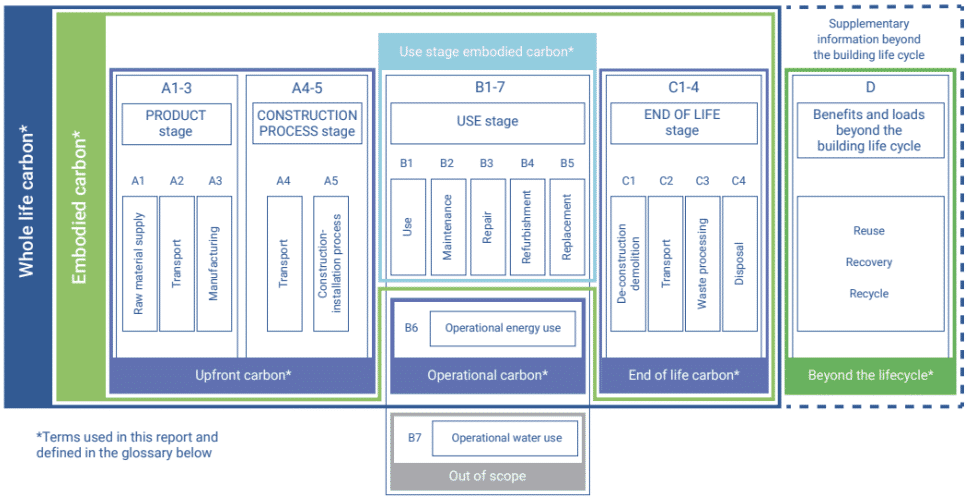
Source: WorldGBC
** Please note that B4, “Refurbishment,” and B5, “Replacement,” have been inverted in the original WGBC publication and in the above image.
The correct stages are: B4, “Replacement,” followed by B5, “Refurbishment.”
Embodied carbon, therefore, includes both upfront and downstream emissions (and excludes modules B6 and B7), as represented in the image above, which was extracted from the WGBC publication “Bringing embodied carbon upfront.”
Upfront embodied carbon

This subset of embodied carbon emissions is most material for new construction assets, as upfront carbon is locked in from the moment the asset is built. These emissions cannot be reverted. However, understanding the upfront emissions associated with the materials used can be used by standing investment portfolios to inform future decisions, such as (1) renovation vs. demolition and (2) how to better dispose of building elements (as this would reduce future downstream embodied carbon emissions).
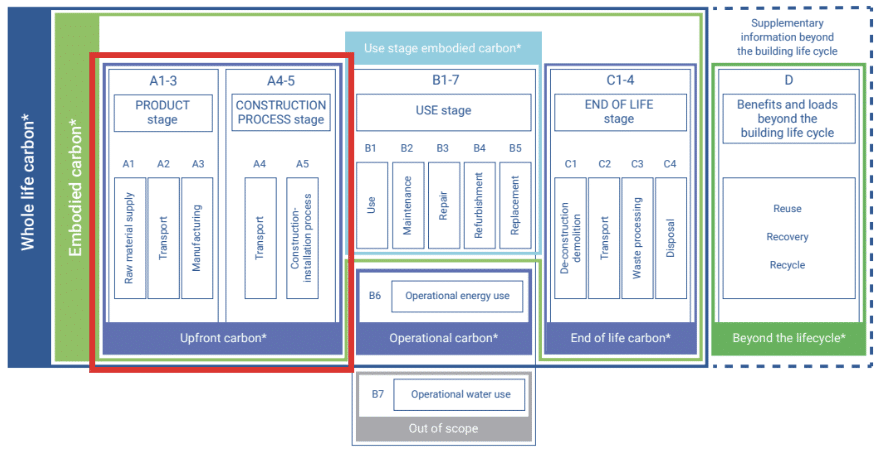
Source: WorldGBC
** Please note that B4, “Refurbishment,” and B5, “Replacement,” have been inverted in the original WGBC publication and in the above image.
The correct stages are: B4, “Replacement,” followed by B5, “Refurbishment.”
Downstream embodied carbon
Downstream embodied carbon emissions occur in two different stages of a building’s life cycle:
- Use stage (B1-5);
- End of life (C1-4).

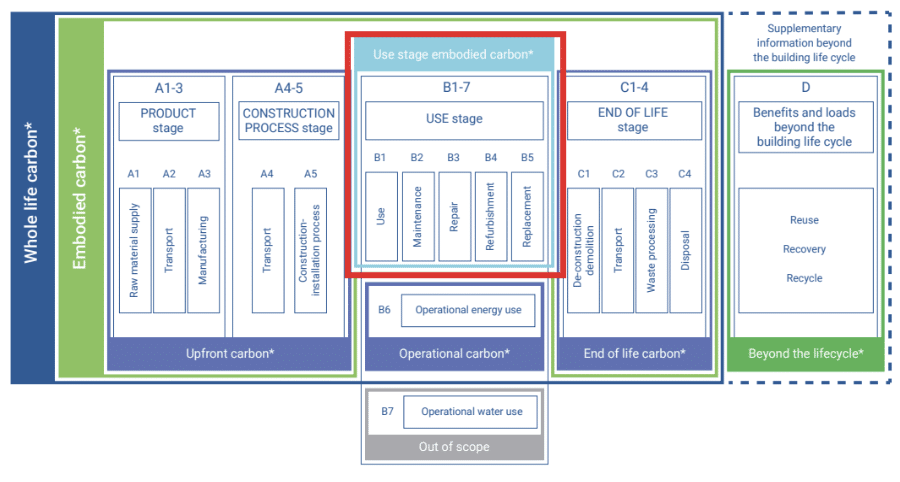
Source: WorldGBC
** Please note that B4, “Refurbishment,” and B5, “Replacement,” have been inverted in the original WGBC publication and in the above image.
The correct stages are: B4, “Replacement,” followed by B5, “Refurbishment.”

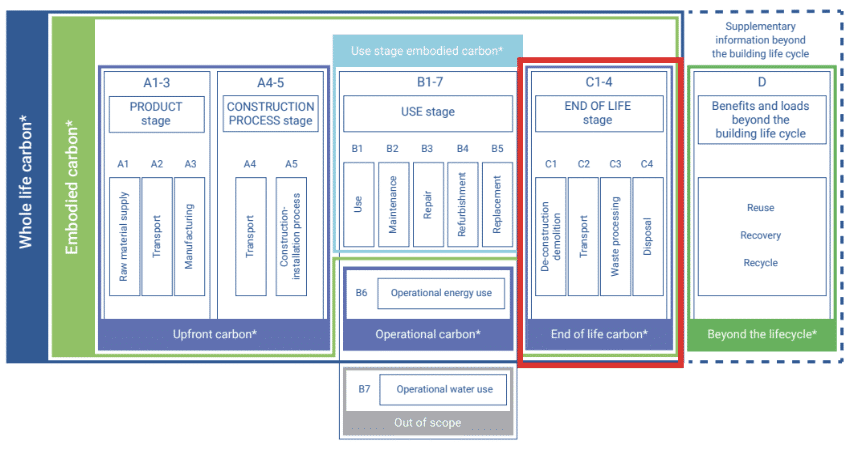
Source: WorldGBC
** Please note that B4, “Refurbishment,” and B5, “Replacement,” have been inverted in the original WGBC publication and in the above image.
The correct stages are: B4, “Replacement,” followed by B5, “Refurbishment.”
Downstream embodied carbon is applicable to both new construction and standing investment portfolios.
Q&A – Embodied Carbon in Real Estate webinar
Below, find the questions raised during the webinar, followed by the answers provided by GRESB and eTool.
What is the relevance of embodied carbon and operational carbon emissions for the Real Estate Sector?
According to statistics released by the World Green Building Council, Architecture2030, and others, the building sector is responsible for 39% of annual global GHG emissions, split into 28% coming from building operations (i.e., operational carbon) and 11% coming from materials and construction processes (i.e., embodied carbon).
This means that, when looking at the emissions only from the building sector, 28% of the total is embodied carbon and 72% is operational carbon.
Is embodied carbon emission counted in Scope 3 GHG emissions?
Embodied carbon emissions can be allocated across Scope 1, Scope 2, and Scope 3 GHG emissions. Understanding who is directly responsible for these emissions is important for properly allocating them to different scopes.
For example, in case these emissions are coming from the reporting entity itself, they will be either Scope 1 or Scope 2 GHG emissions. If these emissions are coming from a third party, they will be Scope 3 GHG emissions.
If I buy a building (i.e., I did not construct the building), is the embodied carbon associated with that building categorized as Scope 1 or Scope 3 emissions?
Embodied carbon emissions associated with an asset acquired by a company would be categorized as Scope 3 GHG emissions, more specifically under GHG Protocol’s Scope 3 subcategory, capital goods.
According to the GHG Protocol: “This category includes all upstream (i.e., cradle-to-gate) emissions from the production of capital goods purchased or acquired by the reporting company in the reporting year. Emissions from the use of capital goods by the reporting company are accounted for in either scope 1 (e.g., for fuel use) or Scope 2 (e.g., for electricity use), rather than in Scope 3. Examples of capital goods include equipment, machinery, buildings, facilities, and vehicles.”
If I acquire an existing building, and the seller did not do an LCA to calculate embodied carbon, is it possible/is there any benefit for me as the next owner to do an LCA (just on the current structure, not any refurbishment)?
Upfront carbon is locked in from the moment the asset is built, and these emissions cannot be reverted. However, understanding the upfront emissions associated with the materials used can inform your next steps with the building, such as (1) renovation vs. demolition, (2) how to dispose of your building elements better, etc., and this would reduce future embodied carbon emissions.
During an embodied carbon analysis, can part of the materials be assessed instead of the whole materials included in the building scope? For example, only the most significant materials, like foundations, structures, and enclosures?
Yes, the scope can be narrowed if that is aligned with the study’s goal. However, this has to be clearly stated in the final report for transparency purposes (i.e., life cycle stages and construction components included). The whole-building calculations are recommended to ensure net positive results from improvement strategies over the asset’s lifespan.
If the foundations can be maintained when a building is demolished you will retain a significant amount of embodied carbon. What do we need to do to encourage architects and civil engineers to retain them OR is it the client/developer who needs to be influenced?
It is important to run an adaptive-reuse analysis as early as possible to understand the pros and cons. Reuse is a powerful strategy to reduce impact when well applied, therefore the whole project team and client/developer need to understand the environmental trade-offs to hit the desired reduction target. Reuse of structural elements will always provide advantages, but attention is needed when reusing components with a short lifespan and with effects in other areas of performance (eg. building envelope will have a significant impact on thermal performance as well as on materials, so a holistic LCA approach is required)
If you are using carbon capture materials (eg. timber construction), will the benefits of carbon sequestration be reflected in the construction phase?
The overall result will depend on the timber product, other extraction, and manufacturing processes, transportation impacts, and end-of-life disposal method assumption. Below, is an extract from Assessing the Carbon-Related Impacts and Benefits of Timber in Construction, a technical paper written by Timber Development UK:
“Essentially, if timber is sourced from a sustainably managed forest, then the sequestered biogenic carbon stored within the product can be considered as part of the assessment. The sequestered carbon is considered to enter the system when the timber is harvested.
In Module A1 (extraction), all the impacts of forestry are accounted for. This covers all the processes that are involved in producing the timber, including growing and planting of seedlings, protection (e.g. from rabbits), maintenance of the forest, for example, regular thinning, and the construction of any roads to enable harvesting, and the harvesting of the timber itself.
If an assessment of embodied or whole life carbon is undertaken at the building level, carbon sequestration, alongside all biogenic carbon emissions and removals, is considered throughout the building life cycle. But if only upfront carbon (Modules A1-A5) is assessed at the building level, or if upfront carbon is to be considered as a separate indicator alongside embodied carbon and/or whole life carbon (for example for an upfront carbon benchmark) then the biogenic carbon sequestered in the products used should not be included in the assessment of the upfront carbon result.”
In addition, according to the RICS Whole Life Carbon Assessment (WLCA) for the built environment:
“Carbon sequestration must only be taken into account when the following criteria are met: 1. The whole life carbon assessment of the project includes the impacts of the EoL stage [C] and 2. The timber originates from sustainable sources (certified by FSC, PEFC, or equivalent).
B1-B3 (in-use modules) are the most complex emissions to account for and very important for standing assets – what would be, in your experience, the best guidance to provide to real estate professionals to predict and capture those emissions?
According to the RICS – Whole life carbon assessment for the built environment:
B1 – “The in-use module [B1] captures the emissions arising during the life of a building from its components, e.g. the release of GHG from HFC blown insulation.”
B2 – “Built assets with sophisticated cladding and MEP installations require regular maintenance to ensure continued efficiency, good appearance, and validity of warranties. All of these repetitive activities involve the use of energy and/or products. These should be accounted for in module [B2].”
B3 – “This module [B3] is intended to provide a reasonable allowance for repairing unpredictable damage over and above the maintenance regime. It is therefore applicable to the same building element categories as maintenance emissions.”
For detailed guidance, please refer to the RICS – Whole Life Carbon Assessment for the built environment framework.
For operational carbon, we have decarbonization pathways like CRREM. Are there similar targets for embodied carbon that companies can try to work towards?
There are organizations working on setting credible targets for the next years to reduce embodied carbon emissions, with the objective of aligning with the Paris Agreement climate goals.
Examples of such organizations are (1) RIBA, (2) LETI, (3) WGBC, (4) Carbon Leadership Forum, etc.
How do we incentivize the masses in the construction and real estate industries to saturate the market with EPDs so we can more accurately calculate a project’s embodied carbon/WLC?
Regulations and rating schemes are providing incentives to project teams that demonstrate increased use of products with EPDs. Product manufacturers are, therefore, realizing the competitive advantage and the significant increase in the number of available EPDs over the years.
What would you say are the largest parts of a building that embodied carbon can be reduced from?
Embodied carbon is directly related to the materials used in building elements/layers. Concrete and steel are carbon-intensive materials used on a large scale for a building’s superstructure and substructure. In addition, cladding (finishes) also contribute to a significant embodied carbon balance.
This means that setting reduction strategies and targets for these building elements will impact your overall embodied carbon emissions. Examples would be (1) building lighter (i.e., review your structural loadings), (2) building wiser (i.e., understand where are your carbon hotspots), and (3) building low-carbon (i.e., alternatives from concrete and steel, avoiding cladding when possible, etc.).
What would be a good level to target for a commercial property that aims to reduce embodied carbon emissions?
From an extract of eTool’s benchmark model, an average embodied carbon intensity for an office building is 1300 kg CO₂e/m². Targeting reductions of 40% in embodied carbon emissions is becoming more common with businesses going net-zero, and is in line with the World Green Building Council (WGBC) recommendations.
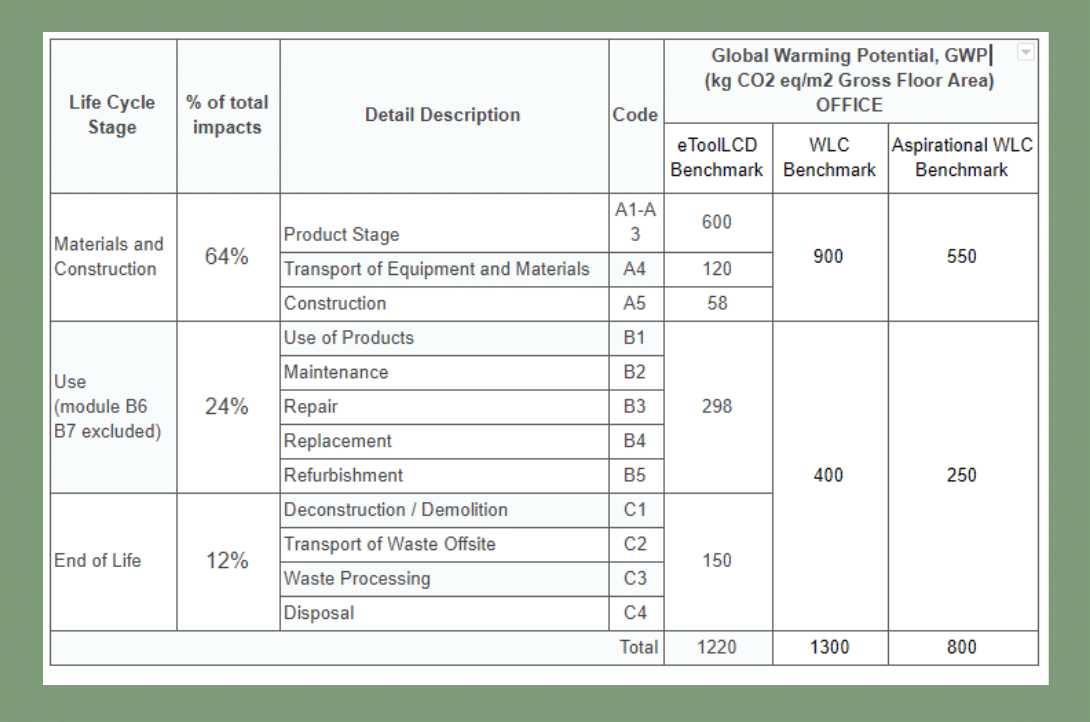
For more information, visit eTool’s post-London Plan Policy – Targeting a reduction in building life cycle carbon emissions.
Is there any embodied carbon reporting framework or template that can be shared?
There are two EN Standards that are widely used to assess embodied carbon emissions:
- EN 15978 – Sustainability Assessment of Construction Works: This standard specifies the calculation method, based on a Life Cycle Assessment (LCA) approach, to assess the environmental footprint of a building.
- EN 15804 – Environmental Product Declarations (EPD): this standard harmonizes the structure for the creation of EPDs for the construction sector, providing transparency and comparable data. EPDs are used to quantify the environmental footprint of a product, which can be aggregated bottom-up to understand the environmental footprint of a building.
In addition, there are industry frameworks that also address embodied carbon. Find a few examples of relevant ones: